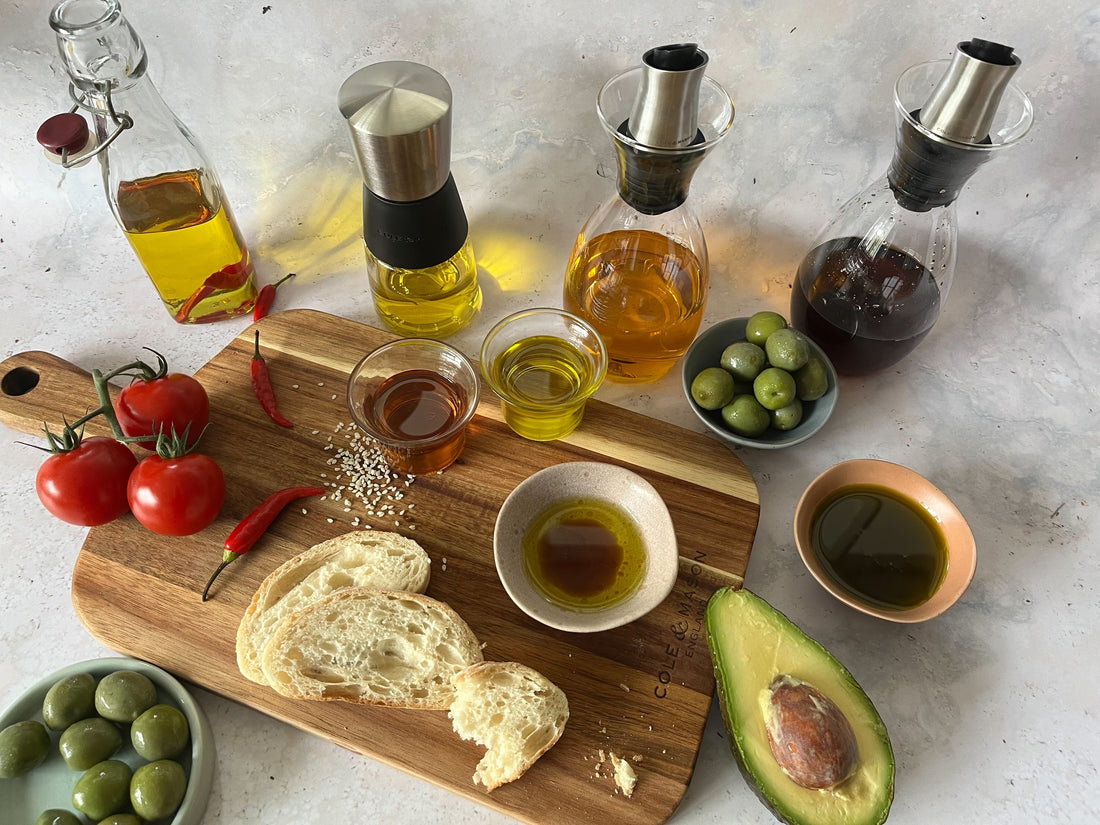
By Angela Patel
There’s quite an array of cooking oils on the supermarket shelves these days from every shade (and price) of olive oil to relative newbies such as avocado and hemp oil. But which one is worth the price and what’s the best one for the type of cooking you are doing? Here’s a quick guide…
Which variety of oil should you choose?
Olive oil
This Mediterranean classic is a staple in most kitchens. The finest quality and most expensive olive oil is made from simply crushing the olives. This is from the first cold pressing and is called extra virgin olive oil. It is dark green in colour with a rich aromatic flavour. Make sure to use this oil sparingly in salad dressings, for dipping or drizzling over roast meat, fish, or vegetables.
After further pressings of the olives, and sometimes heat treatment, the oil becomes paler in colour and slightly thinner in consistency. Oils of this sort are noticeably cheaper than extra virgin olive oil and can be used more liberally in cooking because they have a higher smoking point. They are perfect for frying and are great for salad dressings – it’s worth having a bottle of good quality light olive oil in the cupboard to give a boost of flavour to everyday cooking.
Sunflower oil
This is a reasonably priced oil which is extracted from sunflower seeds. It is a pale yellow colour and mild flavour. It is good for all round cooking but best used for baking, salad dressings and shallow frying.
Rapeseed oil
This oil is produced from the seeds of the rape plant - those golden yellow fields seen across the English countryside throughout summer. It has a deep golden hue and a light delicate flavour. This is perfect for making mayonnaise, salad dressings or for dipping, but also great for shallow frying and baking. Look for cold pressed or extra virgin on the label for the best quality.
Corn oil
Also called maize oil, this is one of the most popular oils for general cooking. It has a fairly bland flavour and a high smoking point which makes it ideal for deep frying but it’s also a good well-priced oil for shallow frying and baking.
Sesame oil
A dark nutty flavoured oil pressed from raw sesame seeds, this oil is frequently used in Asian cookery. It’s great for adding flavour to stir fries and sautéed dishes. You can also buy toasted sesame oil which has a more intensely nutty flavour – save this one to use sparingly for drizzling and Oriental-style dressings.
Avocado oil
This oil is pressed from avocado fruit and not surprisingly has a lovely deep green colour, thick consistency and a mild fruity flavour. As it’s a little pricey, it’s best used as you would an extra virgin olive oil - for dressings, drizzling or dipping but it can also be used for high heat cooking such as frying, sautéing, or roasting.
Hemp seed oil
This oil is cold pressed from hemp seeds and has a pale green colour and a slightly earthy flavour with a hint of nuttiness. Like avocado oil it makes an interesting alternative to olive oil. A good cold pressed hemp seed oil is similar in price to a quality extra virgin olive oil so save for drizzling over grilled or roasted meat, fish and veg, salad dressings and dipping.
Top tips for cooking with oil
- Only use as much oil as you need. The Cole & Mason Epping Oil & Vinegar Mister Spray Bottle is perfect for when you want a light misting of oil on food before cooking. Fish, steaks, chops and vegetables can be lightly sprayed before grilling, roasting or barbecuing.
- When deep frying foods, heat the oil first. Foods absorb less oil and will be crispier if the oil is at the correct temperature - a food thermometer will be a useful tool to check the temperature. But if you don’t have one drop a small cube of stale bread into the hot oil – it should bubble and rise to the surface immediately and turn golden brown in about 30 seconds.
- Take care not to overheat oil – if it starts smoking you will alter the flavour of the oil and the food you’re cooking may have a burnt taste.
- When stir-frying, heat just a sheer coating of oil in a wok until the oil almost starts to smoke. Add the evenly cut ingredients and start stirring immediately to coat them in the hot oil and prevent them sticking to the wok.
- Store bottles of oil in a cool dark place. It’s worth buying a bigger bottle of your favourite oil then decanting a smaller amount at a time into a stylish pouring bottle such as the Cole & Mason Haverhill Oil Pourer. This will be fine on the kitchen work top, just don’t leave it in direct sunlight.
- Save money and make your own flavoured oil by adding fresh woody herbs such as rosemary or thyme, sliced chillies or peeled garlic cloves to a small bottle of oil – choose a light olive oil or rapeseed oil. Leave in a cool dark place for a few days to allow the flavours to slowly infuse. It will keep for up to a month.

